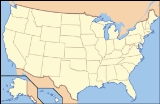
Kobuk Valley Wilderness
Encyclopedia
Kobuk Valley Wilderness is a wilderness area in Alaska
, United States
. It is part of the Kobuk Valley National Park
. The wilderness lies 26 miles (42 km) north of the Arctic Circle
and enclosed by the Baird Mountains
and Waring Mountains mountains, the climate has changed little (or not at all) since the late Pleistocene
era. Remnant flora grow as reminders of the vast Arctic steppe tundra
that once bridged present-day Alaska and Asia.
Alaska
Alaska is the largest state in the United States by area. It is situated in the northwest extremity of the North American continent, with Canada to the east, the Arctic Ocean to the north, and the Pacific Ocean to the west and south, with Russia further west across the Bering Strait...
, United States
United States
The United States of America is a federal constitutional republic comprising fifty states and a federal district...
. It is part of the Kobuk Valley National Park
Kobuk Valley National Park
Kobuk Valley National Park is in northwestern Alaska north of the Arctic Circle. It was designated a United States National Park in 1980 by the Alaska National Interest Lands Conservation Act. It is noted for the Great Kobuk Sand Dunes and caribou migration routes. The park offers backcountry...
. The wilderness lies 26 miles (42 km) north of the Arctic Circle
Arctic Circle
The Arctic Circle is one of the five major circles of latitude that mark maps of the Earth. For Epoch 2011, it is the parallel of latitude that runs north of the Equator....
and enclosed by the Baird Mountains
Baird Mountains
The Baird Mountains are a mountain range located northeast of the Kotzebue Sound, in between the Kobuk and Noatak Rivers in Alaska. The range was named after Smithsonian Institution Secretary, Spencer F. Baird.-Geographical setting:...
and Waring Mountains mountains, the climate has changed little (or not at all) since the late Pleistocene
Pleistocene
The Pleistocene is the epoch from 2,588,000 to 11,700 years BP that spans the world's recent period of repeated glaciations. The name pleistocene is derived from the Greek and ....
era. Remnant flora grow as reminders of the vast Arctic steppe tundra
Tundra
In physical geography, tundra is a biome where the tree growth is hindered by low temperatures and short growing seasons. The term tundra comes through Russian тундра from the Kildin Sami word tūndâr "uplands," "treeless mountain tract." There are three types of tundra: Arctic tundra, alpine...
that once bridged present-day Alaska and Asia.

